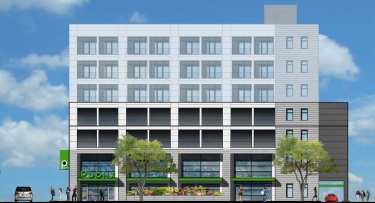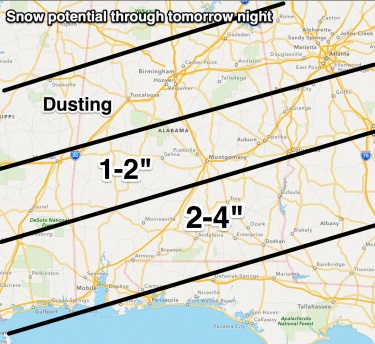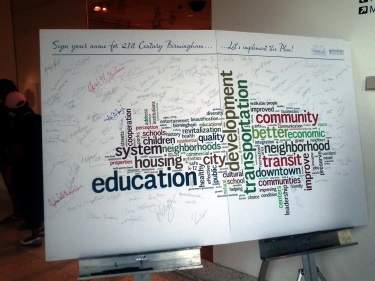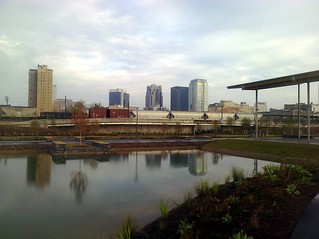 The term “game-changer” has been batted about metro Birmingham a lot in recent days as news of a planned mixed-use development anchored by a Publix grocery store on the city’s Southside spread like wild fire. For those who haven’t heard yet, an article in the May 18 edition of The Birmingham News revealed the Lakeland, FL-based grocer as the main tenant of a $30 million development proposed to sit on the northwest corner of 20th Street and 3rd Avenue South.
The term “game-changer” has been batted about metro Birmingham a lot in recent days as news of a planned mixed-use development anchored by a Publix grocery store on the city’s Southside spread like wild fire. For those who haven’t heard yet, an article in the May 18 edition of The Birmingham News revealed the Lakeland, FL-based grocer as the main tenant of a $30 million development proposed to sit on the northwest corner of 20th Street and 3rd Avenue South.
Now, I’ve lived in the greater downtown area since 2004, and I’ve always had as few as four and as many as six major options available to choose from within 2 miles, but I had to drive to them. When people ask me “Where and how do you get groceries?” I admit I’ve long ago started replying by asking them, “Well, where and how do you get yours?” I get a stunned look, but most times they seem to get what I’m saying. That said, it’s not an option readily or easily available to a significant number of our city’s residents.
This leads to my first reason why it’s a game-changer:
It’s more about WALKING now than DRIVING. Yes, there’s a parking deck that will sit between the ground floor space and the 36 “loft-style” apartments planned for the top the building. The vehicles using these spaces though will be off-street and out of sight. The idea of needing to circle forever to find a spot or the installation of a surface parking lot to handle capacity doesn’t even come up in conversation – and that’s a great thing. It suggests developers realize there will be enough people within walking distance to support its operation. It takes away reliance on an automobile to make a development like this one work.
It means it should be easier to get other national and regional retailers to consider locating a business downtown. It also makes it easier to get those same retailers to start looking at options in neighborhoods throughout the city. It could potentially make the issue of placing parking immediately adjacent to their business less of a sticking point. Dare it be suggested it could also be the first step toward a re-write of the city’s parking regulations and a rethinking of its minimum requirements?
It’s downtown. Actually, this may be an even bigger issue for me and one I’m excited about watching evolve. The proposed building is sitting along 20th Street South. When I first moved here nearly ten years ago, I referred to that area as being downtown while having a conversation with a native; I was chastised immediately because “it was not downtown, it was Southside. Downtown starts on the other side of the tracks.”
It was weird, as most New Yorkers refer to pretty much all of Manhattan as “downtown” no matter which of the other four boroughs you live. I’d also moved here after working for an agency charged with the revitalization of “greater Downtown” Savannah, not just its famous historic district. As a result, I’ve long considered the areas surrounding the city center part of greater downtown Birmingham. It makes sense especially when you get a chance to see just how small the expanded area still is in relation to the rest of the city.
The announcement of this grocery store lends itself to a new approach involving population growth in the urban core focused on eventually seeing people choosing to live in the single-family home dense portions of Druid Hills, Fountain Heights, and Norwood (in addition to others like Titusville, Smithfield, and College Hills) after spending a couple of years living in an apartment located nearby in the city center. Every major news outlet in the city referred to the project’s location area as downtown, suggesting the shift in perspective (one long championed by REV Birmingham and its predecessors) is finally starting to happen. The change in perspective also means a realization about the choices available to someone thinking about their next move.
The changes that come as a result of this and other projects will be quick. The changes at face value will be good for the city. The question right now as we get ready to start watching this happen is “Are we ready for what we’ve been asking for all of these years?”
André Natta is the stationmaster for bhamterminal.com.





 The image to your left is representative of the graphics used by many media outlets in north central Alabama on Monday evening. As you can see, Birmingham and the majority of its surrounding area was only forecast to see a “dusting” of snow. The area that was predicted to receive the brunt of the storm was the southern portion of the state (mostly areas south of Demopolis),
The image to your left is representative of the graphics used by many media outlets in north central Alabama on Monday evening. As you can see, Birmingham and the majority of its surrounding area was only forecast to see a “dusting” of snow. The area that was predicted to receive the brunt of the storm was the southern portion of the state (mostly areas south of Demopolis), 

 There is sure to be a rather large crowd sitting in
There is sure to be a rather large crowd sitting in  There are a lot of people looking to tomorrow, 12/12/12, as a day of significance. It could be a day that marks a new chapter and an evolutionary leap for a community.
There are a lot of people looking to tomorrow, 12/12/12, as a day of significance. It could be a day that marks a new chapter and an evolutionary leap for a community.


Changing the South means changing the attitude
NOTE: I wrote a response to a post shared on Facebook earlier today and felt the need to write this (exceedingly long) addition to/explanation for it.
I almost didn’t go out at all on Friday night. The plan was to crash on the couch after a week of attempting to prove to my laptop who was boss — and losing. A night at home would help me regroup and be ready to play catch up over the weekend.
This meant I was choosing to skip the first Art on the Rocks! of 2015 (complete with preview access to the Hale Woodruff exhibit fresh off a visit to the Smithsonian); three chances to see Garth Brooks and Trisha Yearwood at the BJCC (or a musical); three Barons home games (though I did see the fireworks post-game on Friday from the porch); a screening of Monty Python and the Holy Grail at the Alabama Theatre; and buying a ticket for the first ever heavyweight title fight held in Alabama. That was just what was available in greater downtown (Beer on the Back Porch at Ruffner Mountain was pretty tempting as well on Friday).
Then, Mike Fourcher’s face popped up on my phone:
“Hey, man,! I’m in Bham. Where should I go out?” His phone number followed.
Mike is one of the folks behind Aldertrack, a must-read for political junkies in Chicago, IL. He’s also part of a group of peers I often forget are accessible as I continue to maneuver through the world of journalism, first meeting during the inaugural Block by Block Community News Summit in Chicago nearly five years ago.
I sent a message back saying he’d picked one of the craziest weekends to be visiting. Before I could get the next sentence started (stupid thumbs), he replied:
“I’m here for the Wilder-Molina fight.”
Forty minutes later I find myself sitting on the patio in front of Carrigan’s Pub with Mike and four others. There was a married couple from Texas, another woman, and a guy I later found out was from Queens.
I was asked what I did for a living. I told them about this site and then mentioned my new job working for the Southern Education Desk project. There was some interest in The Terminal, but most of their eyes looked intrigued by the work of the SED — then I found out what they all did for a living…
This is how I ended up having a conversation about the current and future state of Birmingham and issues involving education across the south with Eric Molina’s wife (an A.P. History teacher) and two of their friends (both principals). The guy from Queens was Molina’s attorney. There was no pomp, no fluff. Just a party of six enjoying great local beers (Good People and Cahaba, for the record) and great conversation.
I grew up in a city natives refer to as “the Greatest City in the World” and spent eleven years soaking up life in “the Hostess City of the South.” This September will mark eleven years in Alabama’s Magic City, though I often refer to it as “the City Built to Change the South.” It has done just that on numerous occasions, for better and worse. While some of the episodes many would like to forget were mentioned during the 2+ hours on the patio, most of it was focused on the potential, the progress, and the lessons Birmingham still teaches today.
They enjoyed what they’d already seen and hoped to do things like the Civil Rights Institute as well, wanting to see the important places of history, but also the progress. They felt privileged to be here, excited for the opportunity.
We live in the youngest major city in the southeastern United States, but one with a legacy and road map continuing to influence communities much older, albeit not without some longing for it to live up to its original nickname. Time can often be a brutal and unfair thing as it must pass for things to move forward. The city and the region is still positioned to change the South while still being Southern, leading to conflict among those wishing that wasn’t exactly the case.
There is a scarcity still faced by many in the community, leading some to question our priorities as we continue the process of remaking our city. There’s a fight though — a willingness to change the script and forge ahead, to leading or find a way to do something better. It’s still a scrappy community making big waves, and while many of us are the better for it, many more hope we continue to find ways to include more in the progress and the conversation.
Starting down the slippery slope of whether or not we’re a destination city isn’t necessarily where the conversation needs to currently live. Perhaps it’s about whether or not we’re worthy as a city to continue to dream and push forward so we have the attitude that accompanies being the destination actually shared by more than a few select people. Talking about our place in history should be accompanied with what we’ve done to build on it (& what still needs to be accomplished as we truly start to move forward).
It’s catching though, this positive attitude. This photo shows the property catty-corner of Cotton’s in downtown Ensley. There’s a community willing to dream big enough to think of respected artists designing murals for the wall of the Bethesda Life Center, the building of flower beds, and the belief a place is what you think it can be. It’s everywhere you’re willing to look for it — and tap into it. It may take a lot longer than you’d like, but it’s there for the taking — and for feeding off of if you ever begin to worry.
The energy from the conversation on the porch reminds me just how much fun it can be around here — when you want it to be. Do some egos need to be checked at the door? Yes. Does a can-do attitude need to see the light of day in the hearts and actions of the community as a whole? Absolutely.
We’ve changed the South before. Perhaps feeding off the excitement and the potential while finding opportunities for all will help us do it one more time and continue to help us do so for as long as we’d like.
Leave a comment
Posted in Birmingham, Commentary